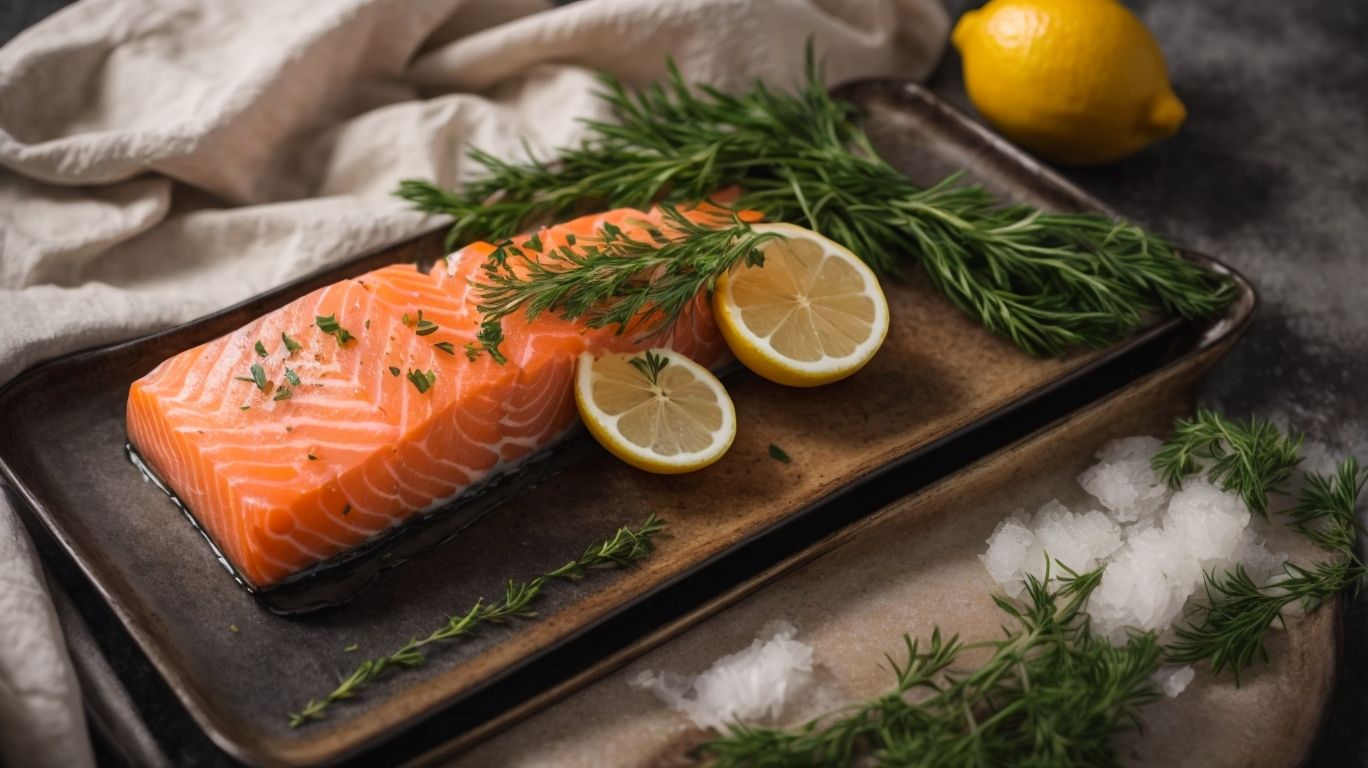How to Bake Salmon Without Skin?
Are you looking to elevate your salmon dish by baking it without the skin?
We will explore the reasons why you may want to remove the skin before baking, the benefits of doing so, and what you’ll need to prepare your salmon for the oven.
From step-by-step instructions on how to remove the skin to seasoning tips and baking techniques, we’ve got you covered.
Stay tuned for some expert tips on how to make the perfect skinless baked salmon dish that will impress your taste buds.
Key Takeaways:
Why Bake Salmon Without Skin?
Baking salmon without skin is a common cooking method that offers various benefits and results in perfectly cooked, moist, and tender fish.
When individuals choose to bake skinless salmon, they often do so to avoid any potential fishy taste that may come from the skin. By removing the skin before baking, the flavors of the salmon itself become more prominent, providing a cleaner and fresher taste experience. Baking salmon without skin allows for more even cooking, as the heat can penetrate the flesh more effectively, resulting in a consistent texture throughout the fillet.
Cooking skinless salmon simplifies the preparation process, as there’s no need to worry about removing the skin post-cooking. This not only saves time but also makes it easier to season the fish and incorporate flavors that enhance the natural taste of the salmon.
Is It Necessary to Remove the Skin?
When baking salmon, removing the skin is not necessary but often preferred by those seeking a skinless, tender dish.
Opting for skinless salmon offers a more consistent cooking experience. The skin can sometimes hold onto fishy flavors that some may find overpowering. By removing the skin, your salmon can absorb marinades and seasoning more effectively, resulting in a well-balanced taste. A skinless salmon fillet reduces the risk of the fish becoming overly oily while baking, allowing the delicate flavors to shine through. Remember to adjust your cooking time slightly when opting for skinless salmon as it may cook faster due to the lack of a protective layer.
What Are the Benefits of Baking Salmon Without Skin?
Baking salmon without skin offers advantages such as avoiding the risk of skin sticking, enjoying a milder flavor, and maintaining a delicate texture.
When you opt for skinless salmon, it allows for more flexibility in seasoning options as the flavors can infuse directly into the flesh. Without the skin acting as a barrier, the heat is distributed more evenly, resulting in a more consistent cook throughout the fish.
Skinless salmon is also a healthier option as it reduces the amount of fat in the dish, making it a lighter choice for those watching their calorie intake. Choosing skinless salmon for your baking needs not only enhances the taste and texture of the dish but also provides a hassle-free cooking experience.
What You’ll Need to Bake Salmon Without Skin
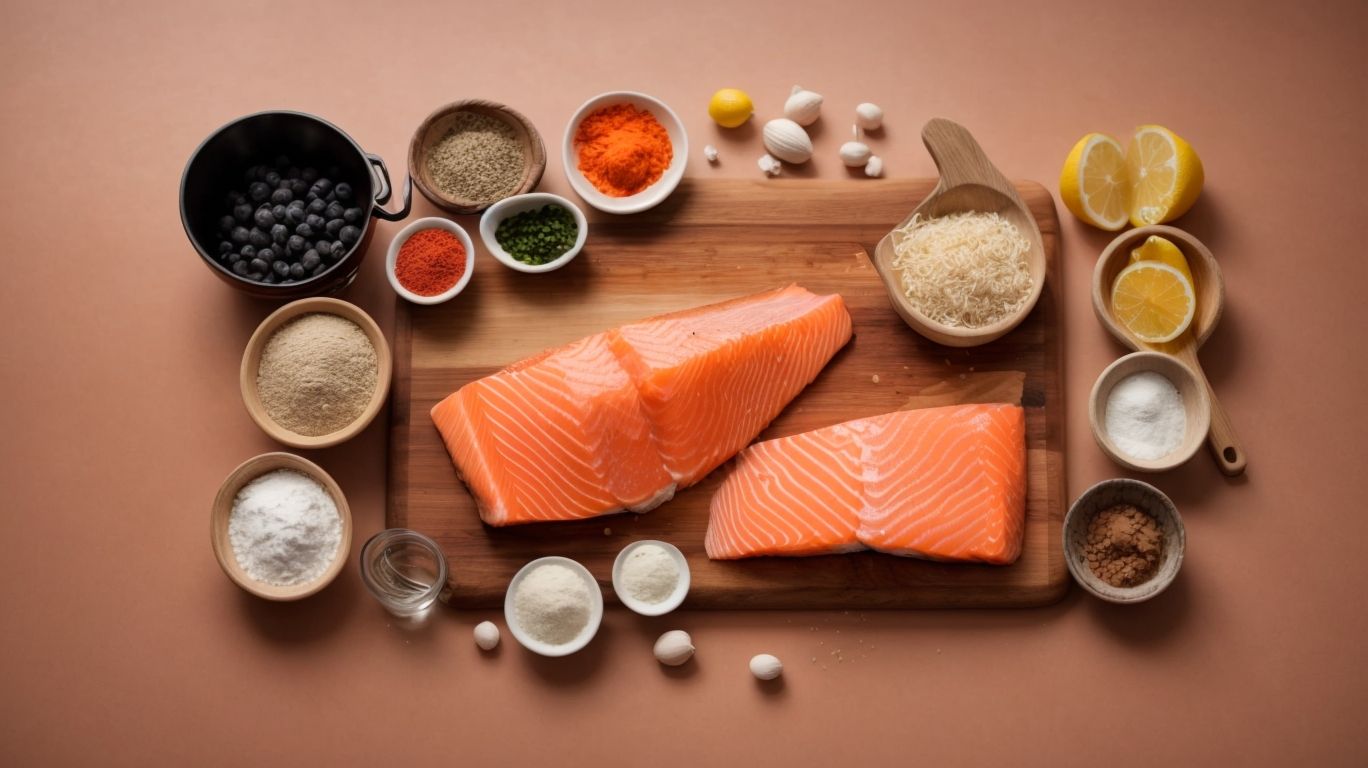
Credits: Poormet.Com – Keith Young
To bake skinless salmon, you’ll need high-quality ingredients that complement the fish and enhance its flavors.
When preparing skinless salmon, incorporating fresh herbs such as dill, parsley, or thyme can add depth and fragrance to the dish. Citrus fruits like lemon or orange provide a zesty brightness that perfectly balances the richness of salmon. Including olive oil for its subtle fruitiness and healthy fats, along with garlic for a savory touch, can elevate the overall taste profile. Don’t forget to season your salmon generously with salt and pepper to enhance its natural flavors. These ingredients work harmoniously to create a mouthwatering salmon dish.
Ingredients for the Salmon
Key ingredients for baking skinless salmon include olive oil, garlic, and thyme, which add depth of flavor and aroma to the dish.
When preparing skinless salmon, olive oil serves as a perfect medium for conducting heat evenly and enhancing the natural richness of the fish. The minced garlic infuses a delightful savory flavor, complementing the delicate taste of the salmon. As for the aromatic thyme, it not only adds a fresh herbal essence but also brings a touch of earthiness that beautifully complements the overall flavor profile of the baked salmon.
Tools for Preparing the Salmon
Plus ingredients, you’ll need tools such as a baking dish and thermometer to ensure your skinless salmon is perfectly cooked.
Regarding preparing and baking skinless salmon, the right tools can make all the difference in achieving that flaky, moist texture and optimal flavor.
- A baking dish is essential for providing a stable and controlled environment for the salmon while it cooks. It helps in keeping the fish moist and prevents it from sticking to the pan.
- On the other hand, a thermometer is a crucial tool for ensuring that your salmon reaches the desired level of doneness. It allows you to monitor the internal temperature of the fish, making sure it is cooked through but not overdone.
How to Prepare the Salmon for Baking?
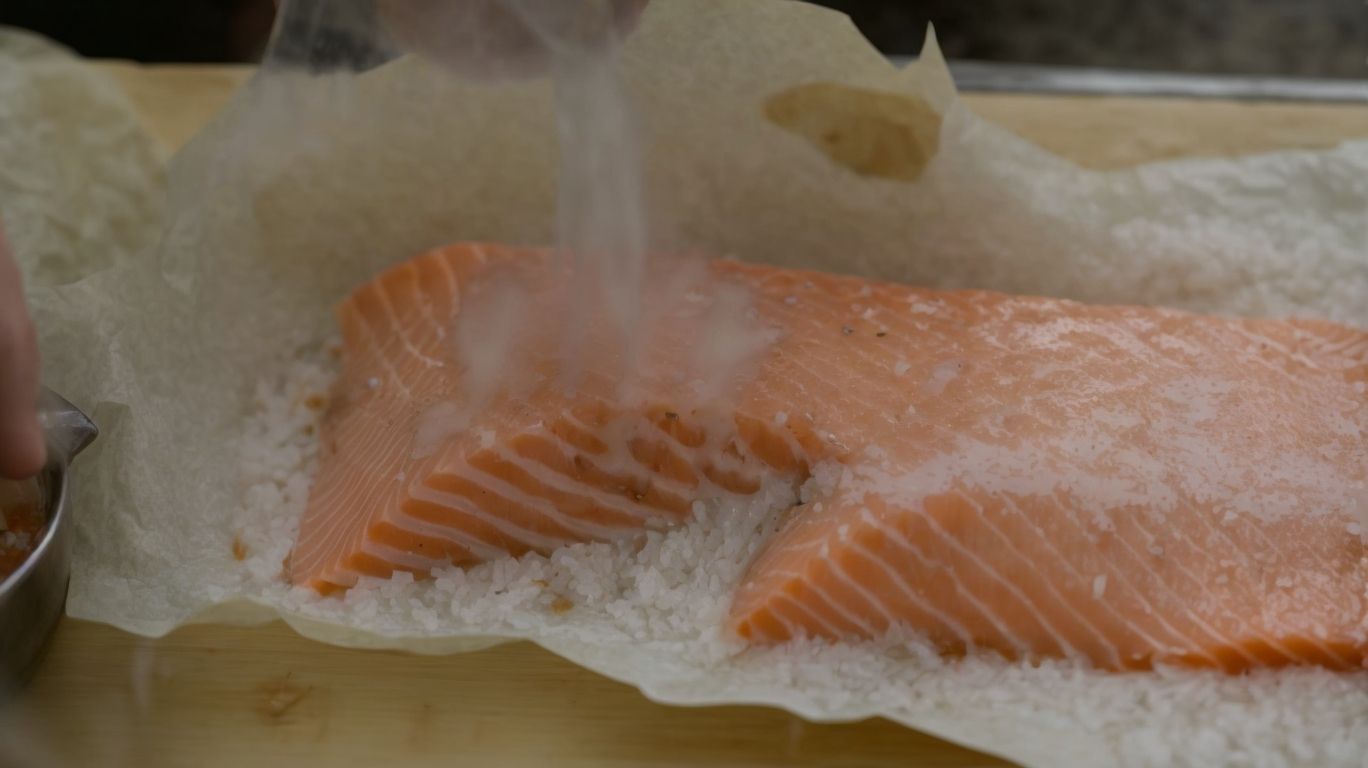
Credits: Poormet.Com – Ralph Lewis
Before baking skinless salmon, it’s essential to properly prepare the fish by removing the skin and seasoning it to perfection.
To start preparing your skinless salmon for baking, ensure you have a fresh piece of salmon that has been descaled and deboned. Using a sharp knife, carefully remove the skin by sliding the blade between the flesh and skin, ensuring a clean separation. Once the skin is removed, pat the salmon dry with paper towels to remove excess moisture, allowing the seasonings to adhere better.
Next, season your skinless salmon generously with your favorite herbs, spices, and a drizzle of olive oil to enhance the flavors. Common seasonings for salmon include lemon pepper, dill, garlic powder, and paprika for a flavorful profile.
After seasoning, let the salmon marinate for at least 30 minutes in the refrigerator to allow the flavors to meld together. This step is crucial for infusing the fish with all the delicious seasoning you’ve added.
Step-by-Step Instructions for Removing the Skin
Begin by gently removing the skin from the salmon fillets, ensuring a clean and even surface for seasoning and baking.
To effectively remove the skin from the salmon, start by placing the fillet skin-side down on a clean cutting board. Using a sharp knife, carefully insert the blade between the flesh and the skin at one end of the fillet. Hold the skin firmly with one hand and slowly slide the knife along the length of the fillet, keeping it as close to the skin as possible to ensure minimal wastage of the flesh. Once the skin is completely separated, discard it and pat the flesh dry with a paper towel to remove any excess moisture.
What Are the Best Ways to Season the Salmon?
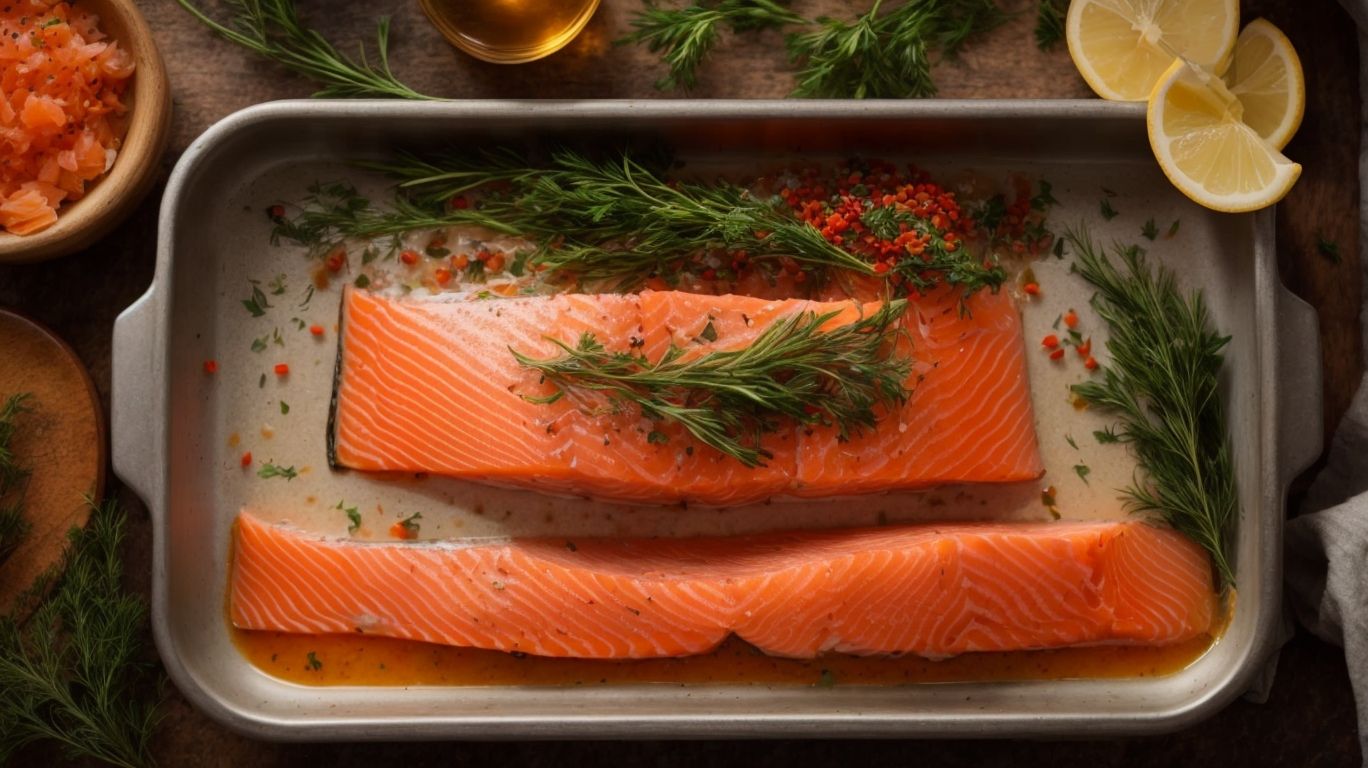
Credits: Poormet.Com – Eugene Hill
Seasoning salmon offers a world of culinary possibilities, from simple lemon and herb blends to spicy Cajun rubs and Asian-inspired soy and ginger marinades.
Each seasoning choice brings its own unique profile to the salmon, enhancing its natural flavors and turning it into a mouthwatering dish.
- Lemon and herb combinations provide a fresh and light taste, perfect for those who prefer a subtle flavor.
- On the other hand, Cajun seasonings add a bold kick with a mix of paprika, garlic, and cayenne, ideal for those looking for a spicy twist.
- Asian-inspired marinades, with the richness of soy sauce and the zing of ginger, create a fusion of flavors that transport you to the bustling streets of Asia.
Simple Lemon and Herb Seasoning
A simple lemon and herb seasoning is a classic choice for enhancing the natural flavors of salmon with a zesty and aromatic touch.
Creating this delicious seasoning involves combining freshly grated lemon zest, chopped herbs such as dill, parsley, and thyme, with a hint of garlic powder, salt, and pepper to achieve a well-balanced blend of flavors.
Once the ingredients are mixed thoroughly, gently pat the salmon fillets dry with a paper towel before generously rubbing the lemon and herb seasoning all over the fish. The zingy citrus and earthy herbs will infuse the salmon, creating a harmonious taste profile.
Spicy Cajun Seasoning
For a bold and spicy kick, try a Cajun seasoning blend on your salmon to add heat and depth of flavor to the dish.
Regarding incorporating Cajun seasoning into your salmon recipe, it’s all about balancing the intense flavors to complement the natural taste of the fish.
To prepare your salmon, first ensure it is properly cleaned and dried. Season both sides generously with the Cajun blend, patting it gently to adhere the spices. This will create a flavorful crust when cooked.
Whether you choose to bake, grill, or pan-sear your salmon, the Cajun seasoning will form a delicious caramelized coating, infusing the fish with a blend of spices that tantalize the taste buds.
Asian-inspired Soy and Ginger Seasoning
For an Asian-inspired twist, consider a soy and ginger seasoning for your salmon, infusing it with savory umami notes and aromatic ginger hints.
When creating this flavorful seasoning blend, start by combining soy sauce, grated fresh ginger, a touch of honey for sweetness, and a sprinkle of garlic powder for added depth. The soy sauce brings a salty richness, while the ginger adds a spicy complexity to the mix.
Applying this seasoning to your salmon is simple yet crucial – make sure to coat the fish evenly, allowing the flavors to penetrate and enhance every bite. Whether you prefer baking, grilling, or pan-searing your salmon, the soy and ginger seasoning is versatile enough to complement any cooking method.
How to Bake Salmon Without Skin?
Baking skinless salmon is a straightforward process that involves seasoning the fish, placing it in the oven, and monitoring its cooking progress for optimal results.
When preparing skinless salmon for baking, it’s important to start by preheating the oven to the recommended temperature, typically around 375°F to 400°F. While the oven is heating up, take your salmon fillets and gently pat them dry with paper towels to remove any excess moisture, which helps the seasoning stick better. Next, you can season the salmon to your preference; popular choices include a simple mix of olive oil, salt, pepper, and herbs like dill or lemon zest.
Step-by-Step Instructions for Baking the Salmon
To bake skinless salmon, preheat the oven, season the fish, place it in a baking dish, and cook until it reaches medium doneness for a moist and tender outcome.
Preheating the oven is crucial as it ensures that the salmon cooks evenly and retains its natural juices. When seasoning the fish, you can use a simple combination of olive oil, salt, pepper, and fresh herbs for added flavor.
Choosing the right baking dish is important; opt for a glass or ceramic dish to help maintain the moisture of the salmon during the baking process.
Cooking time is essential – aim for around 12-15 minutes per inch of thickness to achieve that perfect medium doneness.
What Are Some Tips for Baking Salmon Without Skin?
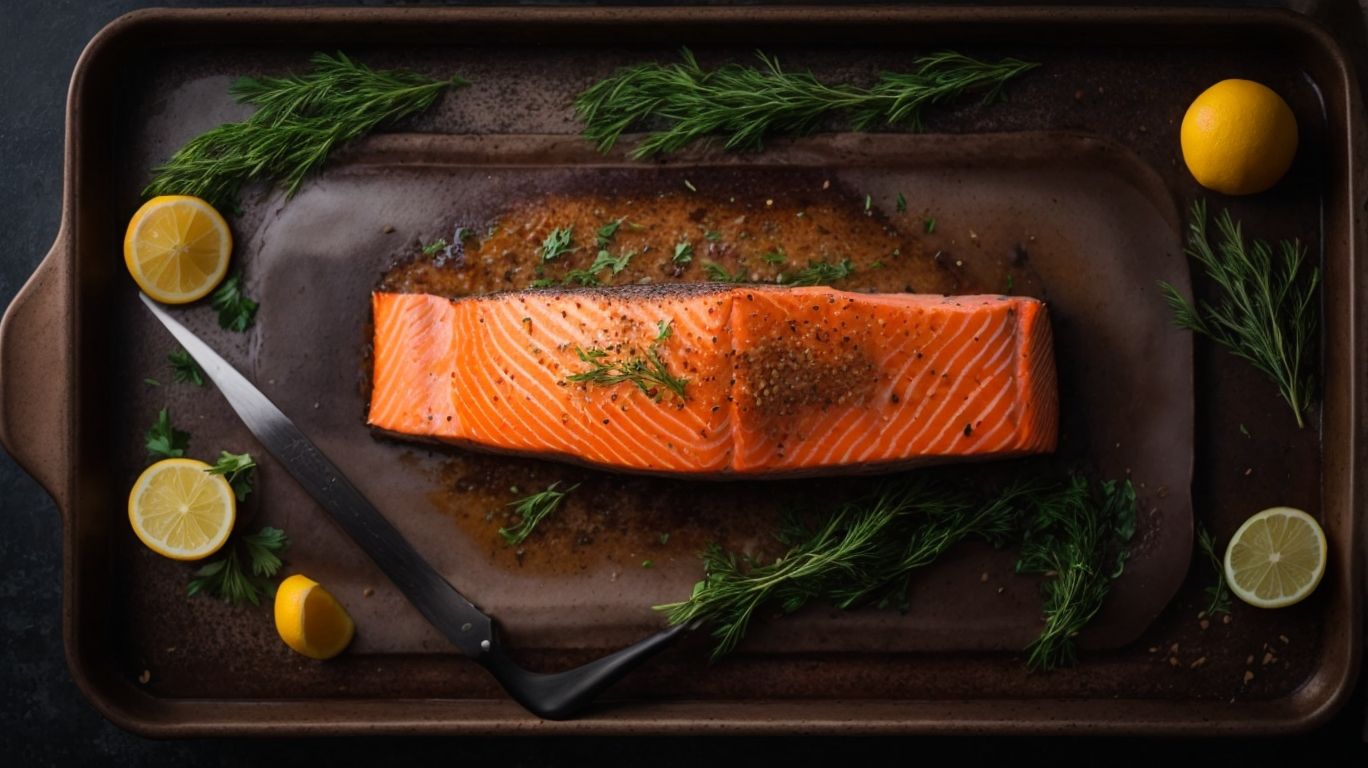
Credits: Poormet.Com – Jeffrey King
When baking skinless salmon, remember to use parchment paper to prevent sticking, monitor cooking time and temperature, allow the fish to rest before serving, and explore creative toppings and sauces for added flavor.
Using parchment paper creates a non-stick surface, making it easier to transfer the cooked salmon to a serving dish without any fragments left behind. Keeping a close eye on the oven temperature and cooking time is crucial to ensure the salmon comes out tender and moist. After baking, let the salmon rest for a few minutes to allow the flavors to settle and the juices to redistribute, resulting in a more succulent dish.
Experiment with different toppings such as a zesty herb crust or a tangy lemon butter sauce to elevate the taste profile of the salmon. The key is to complement the natural flavors of the fish without overpowering them, creating a harmonious and delicious final dish.
Use Parchment Paper to Prevent Sticking
Lay out a layer of parchment paper before placing the salmon in the baking dish to prevent sticking and ensure easy cleanup after cooking.
By using parchment paper when baking salmon, you create a non-stick surface that allows the salmon to cook evenly without adhering to the dish, maintaining its texture and flavors. This method also simplifies the post-cooking cleanup process, saving you time and effort scouring stubbornly stuck bits. When preparing skinless salmon, the parchment paper acts as a protective barrier between the fish and the baking dish, preserving moisture and preventing the fish from drying out.
Monitor the Cooking Time and Temperature
Keep a close eye on the salmon’s cooking time and internal temperature to ensure it reaches the desired doneness without overcooking.
One essential way to avoid overcooking your salmon is to invest in a reliable meat thermometer. This tool will help you monitor the internal temperature accurately. For salmon, the ideal internal temperature for perfect doneness is around 145°F (63°C).
To enhance the flavor and texture, consider marinating the salmon beforehand. Keep in mind that thicker cuts of salmon will require longer cooking times than thinner cuts; adjust the cooking time accordingly. Remember, precise timing and temperature control are key to achieving that moist, tender salmon everyone will love.
Let the Salmon Rest Before Serving
Allow the baked salmon to rest for a few minutes before serving to let the flavors settle and ensure a moist and tender texture.
This crucial step of letting the salmon rest after baking is essential for several reasons. It allows the juices within the fish to redistribute, enhancing the overall taste and richness of the dish. The resting period helps the proteins in the salmon relax, resulting in a more tender and succulent texture when it is finally served.
Get Creative with Toppings and Sauces
Elevate your baked salmon dish by experimenting with a variety of toppings and sauces, such as lemon slices, parsley garnish, or a drizzle of hollandaise sauce.
Don’t be afraid to get creative and mix things up with unique flavor combinations. Consider adding a burst of freshness with diced tomatoes, or a hint of spice with some crushed red pepper flakes. For a subtle touch of sweetness, try a maple glaze or a balsamic reduction.
Regarding presentation, think about adding a colorful array of roasted cherry tomatoes or vibrant grilled asparagus as side accompaniments. Sprinkle some toasted almond slivers or sesame seeds on top of your salmon for an added crunch that complements the dish perfectly.
Frequently Asked Questions
How to Bake Salmon Without Skin?
1. What is the best way to remove the skin from salmon before baking?
The easiest way to remove the skin from salmon is to use a sharp knife and carefully slice between the skin and flesh, starting at the tail end and working your way to the head.
2. Can I still get crispy salmon if I bake it without the skin?
Yes, you can still achieve a crispy texture when baking salmon without the skin. Just make sure to season the flesh well and use a high heat setting.
3. What is the benefit of baking salmon without skin?
Baking salmon without skin can help to reduce the fat content, as most of the omega-3 fatty acids are found in the skin. It also allows for more flavor to be absorbed into the flesh.
4. How do I prevent the salmon from sticking to the baking dish?
To prevent the salmon from sticking to the baking dish, you can line the dish with parchment paper or lightly oil the dish before placing the salmon on it.
5. Can I use any type of salmon for baking without skin?
Yes, you can use any type of salmon for baking without skin. However, it is recommended to use wild-caught salmon for the best flavor and nutritional benefits.
6. How long should I bake salmon without skin?
The cooking time for salmon without skin will vary depending on the thickness of the fillet. As a general rule, bake for about 10 minutes per inch of thickness at 375°F. You can also check for doneness by using a fork to gently flake the fish.

